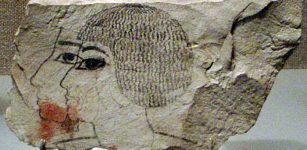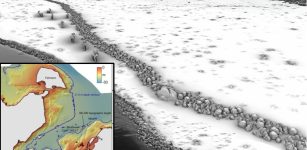Ancient Greek Costumes, Masks And Theater In Focus
Ellen Lloyd - AncientPages.com - What did ancient Greek costumes, masks, and theatre look like? Theater played an important role in ancient Greece. The history of the Greek theater started with festivals held in honor of their gods honoring their gods. A god, Dionysus, was honored with a festival called "City Dionysia".
In the days of Solon, people were often to be seen wandering around the streets during the festival of Dionysus, god of wine. They were clad in goatskins, were smeared with the dregs of wine, and danced and sang rude songs in honor of their god.
These songs were called tragedies. It is interesting to note that tragedy means in Greek mean "goat song," because the goat was sacred to the god whom they thus worshiped. The people were greatly amused by the rude songs and dances.
The birth of theater in ancient Greece
Thespis of Icaria, a Greek poet, and first Greek actor, noticed how popular these amusements were. To please the public taste he set up the first rude theater. In the beginning, it was only a few boards raised on trestles to form a sort of stage in the open air. However, Thespis of Icaria soon built a booth, so that the actors, when not on the stage, could be hidden from public view.
The first plays were very simple and consisted of popular songs rudely acted. Later, the plays became more and more elaborate, and the actors tried to represent some of the tales which the storytellers had told.
Some people disapproved of this kind of amusement. One of them was Solon, who said that Thespis of Icaria was teaching the Athenians to love a lie, because they liked the plays, which, of course, were not true.
However, the plays continued. New actors started playing and great poets wrote works for the stage.
Soon, a huge amphitheater was built. It was so large that there were seats for thirty thousand spectators. Theatre buildings were called a theatron. The theaters were large, open-air structures constructed on the slopes of hills. They consisted of three main elements: the orchestra, the scene, and the audience. Theater in ancient Greece became very popular.
Tragedy, comedy, and satyr plays were theatrical forms. Tragedy and comedy were viewed as completely separate genres.
Three well-known Greek tragedy playwrights of the fifth century are Sophocles, Euripides, and Aeschylus.
Ancient Greek masks and costumes
The Greek actors soon dressed in costume, and all wore masks expressing the various emotions they wished to represent. The Greek term for mask is persona and was a significant element in the worship of Dionysus at Athens. The mask-makers were called skeuopoios or “maker of the properties,” thus suggesting that their role encompassed multiple duties and tasks. Unfortunately, there are no physical remains of ancient Greek masks as they were made of organic materials and not considered permanent objects.

Roman, Republican or Early Imperial, Relief of a seated poet (Menander) with masks of New Comedy, 1st century B.C. – early 1st century A.D., Princeton University Art Museum
Nevertheless, the mask is known to have been used since the time of Aeschylus, an ancient Greek tragedian and considered to be one of the iconic conventions of classical Greek theatre.
From statues and paintings of ancient Greek actors, it is possible to picture what kind of masks and costumes were used. The actors were so far away from the audience that without the aid of exaggerated costumes and masks, they would be difficult to see.
Tragic masks carried mournful or pained expressions, while comic masks were smiling or leering. In a large open-air theatre, like the Theatre of Dionysus in Athens, the classical masks were able to bring the characters’ faces closer to the audience, especially since they had intensely over-exaggerated facial features and expressions.
They enabled an actor to appear and reappear in several different roles, thus preventing the audience from identifying the actor to one specific character. Their variations help the audience to distinguish sex, age, and social status.
Actors who played tragic roles wore boots called cothurneses that elevated them above other actors.
When playing female roles, the male actors donned a ‘ prosterneda’ which is a wooden structure in front of the chest to imitate breasts.
There is little information on theatrical costumes. This is due to the perishable materials they have been made of. Still, we have some information drawn from depictions that decorated ancient pottery.
An actor's entire head was covered by his mask, which included hair. It has been theorized that the shape of the mask amplified the actor's voice, making his words easier for the audience to hear.
The cast of a Greek play in Dionysia was comprised of amateurs, not professionals and all were male.
Ancient Greek actors were forced to gesture grandly so that the entire audience could see and hear the story, but most Greek theatres were cleverly constructed to transmit even the smallest sound to any seat.
Written by Ellen Lloyd – AncientPages.com
Copyright © AncientPages.com All rights reserved. This material may not be published, broadcast, rewritten or redistributed in whole or part without the express written permission of AncientPages.com
Expand for referencesReferences:
More From Ancient Pages
-
 Viking Sword Found In Patara May Have Belonged To A Varangian Guard
Archaeology | Nov 22, 2018
Viking Sword Found In Patara May Have Belonged To A Varangian Guard
Archaeology | Nov 22, 2018 -
 Brihadeshwara Temple – Outstanding Example Of Chola Architecture In Tamil Nadu, India
Featured Stories | Aug 26, 2021
Brihadeshwara Temple – Outstanding Example Of Chola Architecture In Tamil Nadu, India
Featured Stories | Aug 26, 2021 -
 Uruk Was Ruled By Gilgamesh Who Built City’s Great Walls
Featured Stories | Jul 26, 2016
Uruk Was Ruled By Gilgamesh Who Built City’s Great Walls
Featured Stories | Jul 26, 2016 -
 What Was Asphalt Doing On A 9,000-Year-Old Skull Discovered In The Judean Desert
Archaeology | Feb 1, 2022
What Was Asphalt Doing On A 9,000-Year-Old Skull Discovered In The Judean Desert
Archaeology | Feb 1, 2022 -
 Mysterious And Magnificent Pasha Gardens Built For Unknown Reasons
Featured Stories | Oct 8, 2018
Mysterious And Magnificent Pasha Gardens Built For Unknown Reasons
Featured Stories | Oct 8, 2018 -
 Is A Viking Ship Hidden In The Colorado Desert?
Featured Stories | Jan 8, 2018
Is A Viking Ship Hidden In The Colorado Desert?
Featured Stories | Jan 8, 2018 -
 Tomb Of Senenmut And Earliest Known Star Map In Ancient Egypt
Civilizations | Nov 17, 2016
Tomb Of Senenmut And Earliest Known Star Map In Ancient Egypt
Civilizations | Nov 17, 2016 -
 Curious Bannerstones Used By Prehistoric Native Americans For Unknown Purpose
Artifacts | May 31, 2021
Curious Bannerstones Used By Prehistoric Native Americans For Unknown Purpose
Artifacts | May 31, 2021 -
 The Bushido Code: Centuries-Old Unwritten Code For Ideal Samurai Warrior
Featured Stories | Dec 26, 2016
The Bushido Code: Centuries-Old Unwritten Code For Ideal Samurai Warrior
Featured Stories | Dec 26, 2016 -
 First Dream Of The New Year – Japanese Hatsuyume Tradition
Ancient Traditions And Customs | Jan 1, 2025
First Dream Of The New Year – Japanese Hatsuyume Tradition
Ancient Traditions And Customs | Jan 1, 2025 -
 Before The Pharaohs: The Evidence For Advanced Civilization In Egypt’s Mysterious Prehistory
Civilizations | Apr 14, 2017
Before The Pharaohs: The Evidence For Advanced Civilization In Egypt’s Mysterious Prehistory
Civilizations | Apr 14, 2017 -
 Georgia Guidestones Damaged By An Explosive Device – By Whom And Why?
News | Jul 7, 2022
Georgia Guidestones Damaged By An Explosive Device – By Whom And Why?
News | Jul 7, 2022 -
 Previously Unknown 2,000-Year-Old Celtiberian City Discovered- Has The Lost City Of Titiakos Been Found?
Archaeology | Jul 18, 2023
Previously Unknown 2,000-Year-Old Celtiberian City Discovered- Has The Lost City Of Titiakos Been Found?
Archaeology | Jul 18, 2023 -
 Elk Tooth Rattlers And People’s Dance 8,000 Years Ago
Archaeology | Jun 4, 2021
Elk Tooth Rattlers And People’s Dance 8,000 Years Ago
Archaeology | Jun 4, 2021 -
 Controversial Tunnel Plan Near Stonehenge Gets U.K. Government Approval – Shocked And Angry Opponents Will Challenge The Decision In High Court
News | Nov 13, 2020
Controversial Tunnel Plan Near Stonehenge Gets U.K. Government Approval – Shocked And Angry Opponents Will Challenge The Decision In High Court
News | Nov 13, 2020 -
 Mysterious Medes: Was It An Ancient City Of Ecbatana?
Archaeology | Jul 3, 2020
Mysterious Medes: Was It An Ancient City Of Ecbatana?
Archaeology | Jul 3, 2020 -
 7,000-Year-Old Unique Lipnik Idol Statuette Unearthed In Moravian Gate Valley, Czech Republic
Archaeology | Dec 14, 2015
7,000-Year-Old Unique Lipnik Idol Statuette Unearthed In Moravian Gate Valley, Czech Republic
Archaeology | Dec 14, 2015 -
 Ancient Petroglyphs In Toro Muerto Are Not What We Thought – Archaeologists Say
Archaeology | May 24, 2024
Ancient Petroglyphs In Toro Muerto Are Not What We Thought – Archaeologists Say
Archaeology | May 24, 2024 -
 Nygrotta: Species Migration Occurred Due To Climatic Shifts Millennia Ago – Ancient DNA And Bones Show
Paleontology | Apr 5, 2024
Nygrotta: Species Migration Occurred Due To Climatic Shifts Millennia Ago – Ancient DNA And Bones Show
Paleontology | Apr 5, 2024 -
 Underwater Drone Images Reveal Oldest Human-Made Structure In The Baltic Sea
Archaeology | Feb 13, 2024
Underwater Drone Images Reveal Oldest Human-Made Structure In The Baltic Sea
Archaeology | Feb 13, 2024







